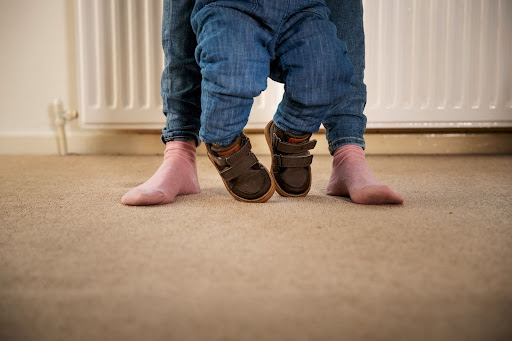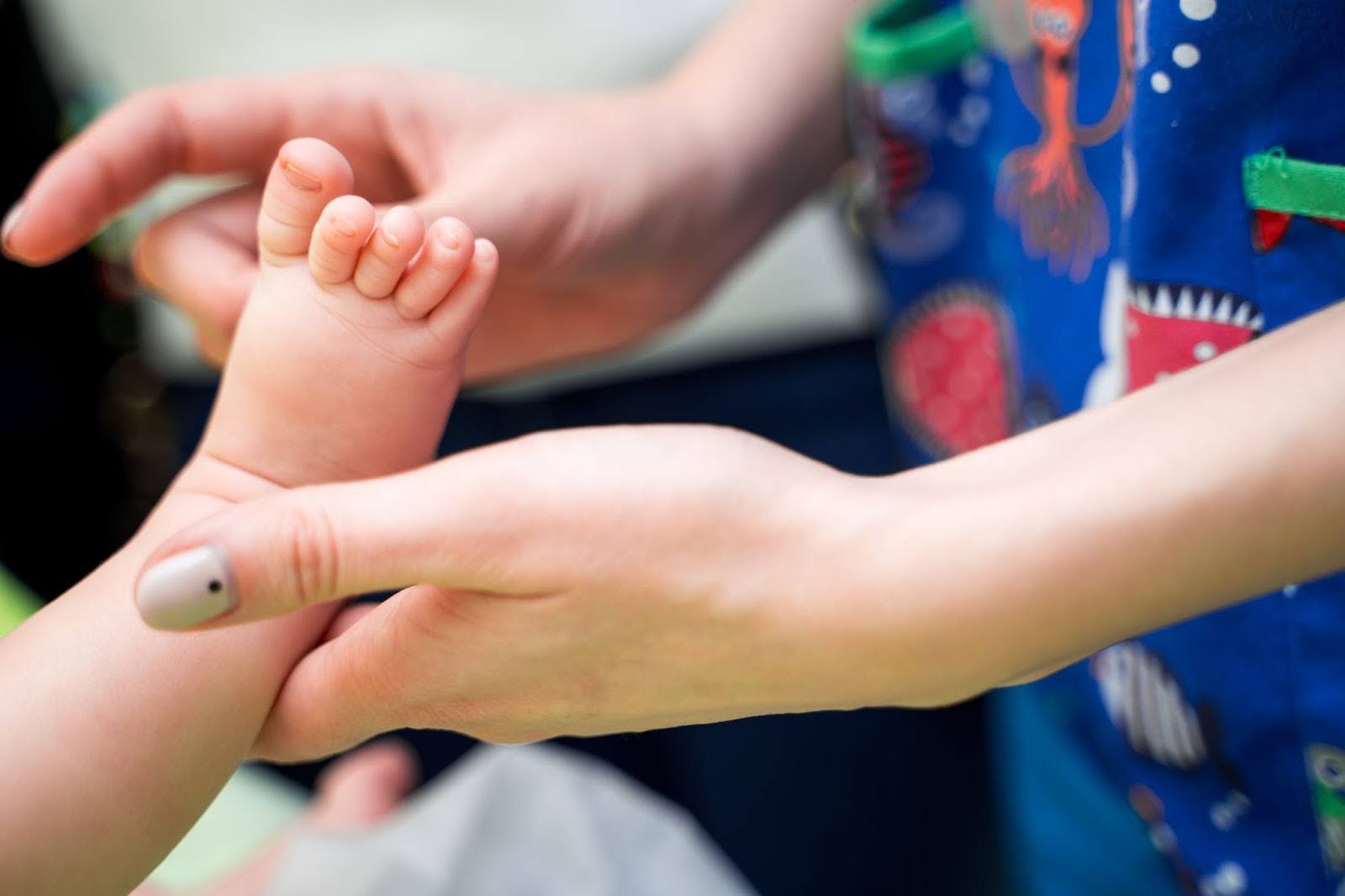

Source: Child-Toe-Walking1 by Walkezstore.com Custom Orthotics
Source: little-baby-legs-go-on-track by Shutterstock
Toe Walking is defined as the failure of the heel to contact the floor at the onset of stance during the gait cycle, resulting in a bilateral toe to toe gait. Toe walking is a walking pattern in which the child walks on their toes or the balls of their feet, and there’s no contact of the heel to the ground. Toe walking is very common in young children who are under 3 years of age; however, in children 3 years and older, walking on tiptoes may not be normal and could be associated with a neurological immaturity or medical condition. Fortunately, over 90% of these cases can be treated with conservative treatment options, and surgery is not required.
Background
Toe Walking is fairly common in children just learning to walk but is something most children outgrow. Children who continue to walk on their tiptoes or ball of their feet past their toddler years frequently do it simply out of habit. This by itself usually isn’t anything you need to be concerned about as long as your child is developing and growing normally, but toe walking after the age of 3, referred to as Idiopathic Toe Walking, may not be normal and should be looked into.
A study by Sobel et al. revealed that the majority of children who present with Idiopathic Toe Walking (ITW) had a normal birth weight, walked on time, began to toe walk immediately in their gait development, stood mostly in plantigrade (feet flat), were able to demonstrate heel-toe gait when instructed, and only toe walk intermittently.
It is theorized that ITW may be one element of a more global neurodevelopmental condition since many of these children present with other diagnoses concomitantly. Many young children are recognized as having a toe-walking tendency when they first start to walk, which is not considered an anomaly. However, if this pattern persists beyond3 years of age, it should be labeled as ITW in the absence of any other pathology. A study by Le Cras et al. reported a higher incidence of ITW in males as compared to females and that a family history of ITW often exists.
What is Idiopathic Toe Walking?
Idiopathic Toe Walking (ITW), as its name implies, refers to the manifestation of this gait pattern without a known underlying pathological cause. This is a diagnosis of exclusion, in which other conditions causing an equinus gait have been ruled out. Idiopathic Toe Walking (ITW) is when a child, three and older, continues to walk on their toes without showing any signs of a neurological, orthopedic, or mental illness. The NIH’s National Library of Medicine says ITW effects between 7 and 24 percent of children. When a child walks on their toes for an extended period of time, the bones and ligaments in the knees, hips, and lower back are placed under unnatural tension. ITW can lead to improper bone growth and/or ligament overstretching, placing youngsters at risk for injury and joint discomfort as they age.
Some features of idiopathic toe walking include:
- walking on tip toes on both sides
- constantly balancing on their toes
- walking with straight knees
- being able to stand with their feet flat on the ground or walk with flat feet when asked to do so
- have a family history of toe-walking
- exaggerated toe walking when walking barefoot but better when wearing shoes
- increased toe walking when walking on surfaces that increase sensory input, such as carpet, cold tiles, and grass
Whilst the cause of idiopathic toe walking is unknown, there are many factors that may contribute to the development of toe walking. These may include:
- altered proprioceptive processing – problems sensing the body’s position in space
- issues with tactile processing – often an increased response to touch sensations
- issues with vestibular processing – problems maintaining balance
- overall body strength
- family history – toe walking is more common in children whose parents or siblings also have a history of toe-walking
- joint hypermobility
- flexibility of leg and foot muscles – idiopathic toe walkers not only often have tightness in the calf muscles but also restricted hip range of motion and tightness in the iliotibial band, all of which alter their walking pattern

Source: ec373edf-2c2b-450f-8576-4ab7d06efae5 by Boston Children’s Hospital
Toe Walking Diagnosis
When evaluating a pediatric patient for toe-walking, it is essential to take a comprehensive medical history and conduct a thorough physical examination. During the initial consultation, consider asking the following questions:
- How long has the child been walking?
- When did the child begin toe-walking?
- Is the toe-walking a recent development?
- Can the child walk on their heels?
- Is there a family history of toe-walking?
- Does the child have any underlying medical conditions?
- Was the child born prematurely?
In addition to gathering this history, observe the child’s gait closely. Conduct a physical examination to assess their range of motion and muscle tone. An electromyography (EMG) test may be necessary to evaluate muscle response. If you suspect conditions such as autism or cerebral palsy, consider ordering neurological testing to further investigate.
Differential Diagnosis
In considering differential diagnosis, it is important to take into account any potential underlying neuromuscular or musculoskeletal conditions. Toe walking may be caused by Cerebral Palsy, congenital contracture of the Achilles tendon, or paralytic muscular disorders such as Duchenne Muscular Dystrophy. Idiopathic Toe Walking may be associated with developmental disorders such as Autism or other myopathic or neuropathic disorders.
The majority of disorders causing toe walking can be ruled out through history and physical examination, resulting in a diagnosis of Idiopathic Toe Walking. A child with a diagnosis of ITW will present with a normal neurological exam with respect to muscle tone, reflexes, sensation, and strength. The child may or may not have a passive limitation in ankle dorsiflexion. Idiopathic Toe Walking will always exhibit bilateral and symmetrical presentation, as opposed to some other neurologic conditions that may cause unilateral or asymmetric toe walking.
Sensory Connection
Idiopathic toe walking may be linked to hyper or hyposensitivity. Some children may not like the feeling of different surfaces on their bare feet, which causes them to rise up on their toes to avoid having the full surface of their feet contracting the floor. For children who are seeking more input, toe walking increases the force of impact felt during ambulation, as the ground reaction force is distributed through a smaller surface area at the metatarsal heads.
Differential Diagnosis of Persistent Toe Walking
| Diagnosis | Clinical Clues |
| Cerebral palsy (CP) | Concerning birth history, developmental delays, upper extremity involvement, asymmetries, upper motor neuron signs, +/- fixed contractures, |
| Peripheral Neuropathy | Pertinent family history, sensory complaints (numbness, etc) and/or sensory deficits on the exam, lower motor neuron signs (absent DTRs, atrophy), cavovarus feet or hammertoes |
| Autism Spectrum Disorder (ASD) | Speech delay (w/ normal hearing), impairments in social communication, stereotypic behaviors, poor eye contact, ID or normal intelligence, hypersensitivities |
| Hereditary Spastic Paraplegia (HSP) | Looks like CP! ..But, neuroimaging is normal and often a positive family history. Clinically will have spasticity + weakness |
| ADHD | Intermittent toe walking (less likely to contract). Hyperactivity, impulsivity, and/or inattentiveness leading to impaired functioning in 2 or more settings (e.g., school and home) |
| Syndrome | Dysmorphism features, global delays, hypotonia, seizures, family history of similar concerns |
| Spinal Cord Disorder | Bowel and bladder dysfunction, upper and/or lower motor neuron signs, lower extremity pain/weakness/numbness, spinal dysraphism (mass, dimple, tuft of hair), progressive foot deformity |
| Idiopathic | Persistent toe walking, may or may not have fixed ankle contractures, often have an FH of toe walking, none of the other above features |
Exam/Assessment
In order to best determine an ideal treatment protocol, a comprehensive history should be taken. Children who ambulate later or skip developmental milestones, which limit weight bearing, often present with ITW later on.
- Does the child toe walk when wearing shoes?
- Do you notice more or less toe walking when ambulating barefoot on different surfaces? For instance, sand at the beach, grass at the park, hardwood floor, carpet.
- Is the child able to achieve and maintain full range of motion at the ankle?
- Evaluate passive vs active range of motion of gastrocnemius, soleus, and hamstring complex.
- Assess the child’s overall lower extremity biomechanics from position of the pelvis, knees, and feet.
- Assess the child’s static vs dynamic arch formation of the foot. Oftentimes times, children with ITW will have weak intrinsic plantar muscles and use toe walking to compensate.
Treating Toe Walking
Children who simply toe walk out of habit do not require treatment. They usually outgrow the habit eventually. However, if your pediatric podiatrist determines a physical issue is causing the toe walking, treatment may include:
- Physical therapy exercises to strengthen and stretch muscles in the legs and feet


Source: clubfootDF by Dinosaur Physical Therapy
Source: Assisted_stretch_for_young_child by The Royal Children’s Hospital Melbourne
- Leg braces or a splint to correct gait
- Custom orthotics
- Serial below-the-knee casting to properly align the toes to the shin
- Botox injection and surgery
- Proper shoe selection
Hope this helps!
Gayane Zakaryan
Head of Rehabilitation Services
«ArBeS»



